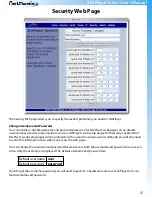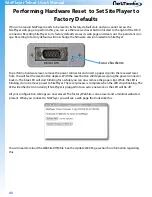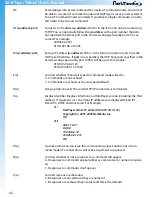
37
SitePlayer Telnet User’s Manual
SitePlayer can operate in binary or Network Virtual Terminal (NVT) mode. In binary mode it passes all char-
acters unchanged back and forth through the Telnet port. In NVT mode is uses character 255 (FF hex) as an
escape character to control behavior.
Daytime
This service is used to get the elapsed time that SitePlayer has been running. To get the elapsed time, you
need to open a TCP/IP connection to SitePlayer on port 13 and read the data from that port. The easiest way
to do this is to run the
telnet
program with port 13. For example,
telnet 192.168.2.7 13
Discard
This service throws away any TCP/IP data that is sent to it. This is used mostly for speed testing. The default
port for discard is 9.
UDP Serial (UDPS)
This is a SitePlayer specific protocol which uses UDP to send and receive serial data. UDPS is a specialized
protocol. Data that is received by SitePlayer’s serial port is transmitted using UDP and the default port of
10001. SitePlayer can be configured to send UDPS data to a specific IP address or the first IP address that
sends it UDPS data. If configured for a specific IP address, SitePlayer can send data at any time to that ad-
dress. Otherwise, SitePlayer will wait to received data so it can determine the response IP address. The
response IP address can change depending on the last IP address SitePlayer received UDPS data from. This
allows more than one computer to poll SitePlayer for data.
If you want to restrict SitePlayer to only communicate with one computer, then you can use the Security
Web page to restrict port 10001 to that particular computer’s IP address.
UDPS is useful in a polling environment where a master computer polls multiple slaves for data. The master
computer would send a data packet which elicits a response from the device attached to SitePlayer. The data
would then be sent to the master computer.
Telnet (TCP/IP) takes precedence over the UDPS. UDPS is disabled while a TCP/IP connection is active on the
serial port.
One limitation of UDPS is that the source IP address in the UDP packet will be the first available IP address
that SitePlayer uses. SitePlayer chooses the source IP address in the following order:
1. Static IP address 1
2. Static IP address 2
3. DHCP address
4. Link Local Address
So if you were to send a UDP packet, for example, to SitePlayer to its DHCP address, it would respond with
it’s Static IP address #1 as its source IP address. If Static IP address #1 were not set, then it would use Static IP
address #2 and so on.
Содержание SitePlayer Telnet Series
Страница 50: ...SitePlayer Telnet User s Manual 50 Telnet Carrier Schematic ...
Страница 52: ......
















































